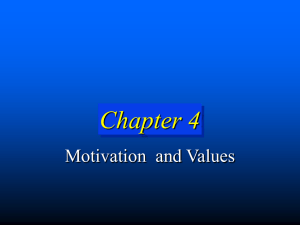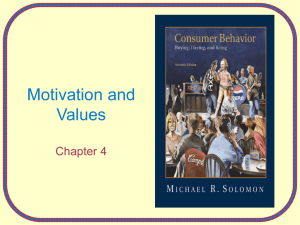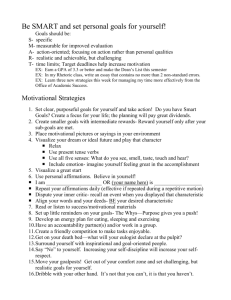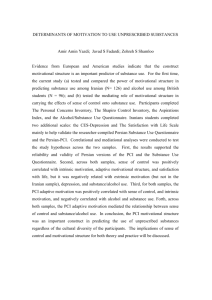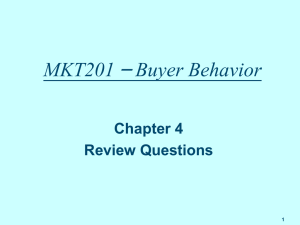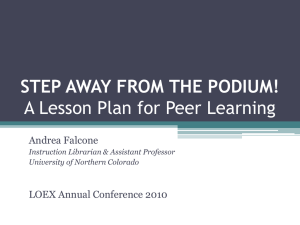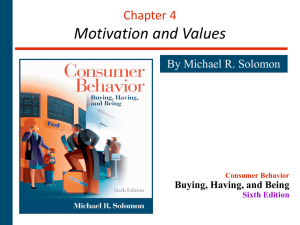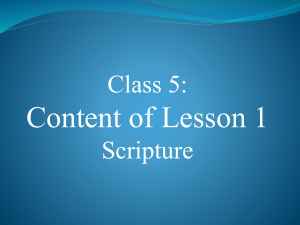Motivation and Values
advertisement
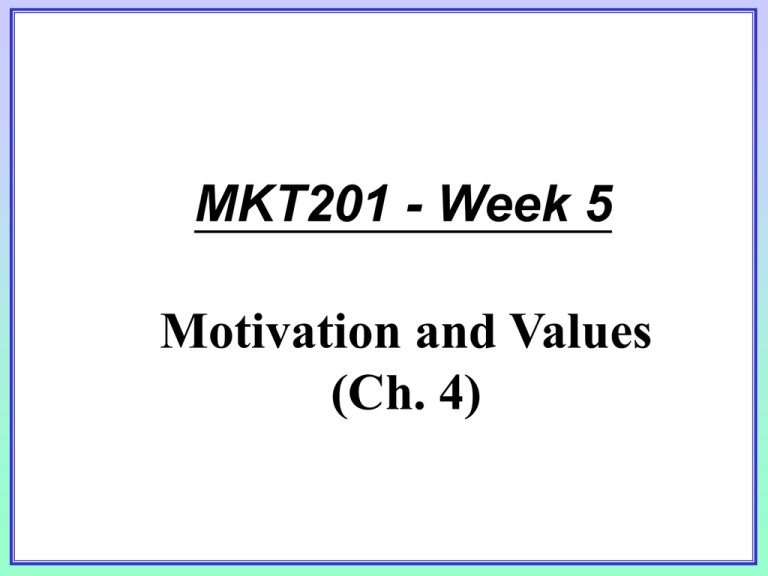
MKT201 - Week 5 Motivation and Values (Ch. 4) Motivation: Introduction • What are the forces that drive people to buy and use products (or Not to buy/use)? ? Emotional response ? Values ? Priorities ? Beliefs? • To under Motivation is to understand why consumers do what they do. The Motivation Process • Motivation: – The processes that lead people to behave as they do. It occurs when a need arises that a consumer wishes to satisfy. • Utilitarian need: Provides a functional or practical benefit • Hedonic need: An experiential need involving emotional responses or fantasies • Goal: – The end state that is desired by the consumer (desired end state). The Motivation Process • Drive: – The degree of arousal present due to a discrepancy between the consumer’s present state and some ideal state (note: the discrepancy leads to a creation of tension ) • Want: – A manifestation of a need created by personal and cultural factors • Motivation can be described in terms of: – Strength: The pull it exerts on the consumer – Direction: The particular way the consumer attempts to reduce motivational tension The Motivation Process Tension To fulfill a need Motivational Strength Drive = degree of arousal Motivational Direction The way to reduce the tension Behavior Creation of want is affected by personal and cultural factors Want Goal Desired end state Ads Reinforce Desired States • This ad for exercise shows men a desired state (as dictated by contemporary Western culture), and suggests a solution (purchase of equipment) to attain it. Motivational Strength • Biological Versus Learned Needs • Early work attribute behaviour to instinct • Tautology (circular explanation for behavior related to instinct; e.g. buying status-associated products because … motivated to attain status) – Drive Theory • Focus on biological needs • Homeostasis (balance – eliminate unpleasant state) – Expectancy Theory • Focus on cognitive factors (expectations of achieving desirable outcomes) Motivational Strength The Degree to Which a Person is Willing to Expend Energy to Reach One Goal as Opposed to Another. Biological Vs. Learned Needs Drive Theory Focuses on Biological Needs that Produce Unpleasant States of Arousal, i.e. Hunger. Homeostasis: Behavior Which Tries to Reduce or Eliminate This Unpleasant State and Return to Balance. Expectancy Theory Behavior is Largely Pulled by Expectations of Achieving Desirable Outcomes - Positive Incentives - Rather Than Pushed From Within. Motivational Direction Needs Versus Wants Specific Way a Need is Satisfied (the Want) Depends on: Individual’s Unique History, Learning Experiences and Cultural Environment. Types of Needs Biogenic Food, water, air, shelter Psychogenic Objective, tangible product attributes Power, affiliation Utilitarian Hedonic Calories, miles per L Excitement, fantasy Instant Gratification of Needs • We expect today’s technical products to satisfy our needs – instantly. Motivational Conflicts • Goal valence (+ve or –ve) – Positively-valued goal: approach – Negatively-valued goal: avoid • (socially disapproved products e.g. deodorant, mouthwash) • Positive and negative motives often conflict with one another Motivational Direction Types of Motivational Conflicts Approach-Approach Two Desirable Approach-Avoidance Alternatives Negative Avoidance-Avoidance Consequences Two Undesirable Burger Vs Noodle Consequences Ice-Cream Vs Slim body Theory of Cognitive Dissonance (psychological inconsistency between 2 or more beliefs/behaviors Repairing old car Vs Buying new car Solutions to Approach-Avoidance Conflict (good food without the calories) Negative Consequences • The Partnership for a Drug-Free America points out the negative consequences of drug addiction for those who are tempted to start. Classifying Consumer Needs • Henry Murray’s NEED dimensions: – Autonomy: Being independent – Defendance: Defending the self against criticism – Play: Engaging in pleasurable activities • Thematic Apperception Technique (TAT): (personality tests with ambiguous pictures) – (1) What is happening? – (2) What led up to this situation? – (3) What is being thought? – (4) What will happen? – People freely project their subconscious needs onto the stimulus (or picture) Classifying Consumer Needs (cont.) • Specific Needs and Buying Behavior: – Need for achievement: To attain personal accomplishment – Need for affiliation: To be in the company of others – Need for power: To control one’s environment – Need for uniqueness: To assert one’s individual identity • Maslow’s Hierarchy of Needs: – A hierarchy of biogenic and psychogenic needs that specifies certain levels of motives. (gardening may satisfy needs at every level!!) Maslow’s Hierarchy of Needs Figure 4.2 Criticisms of Maslow’s Hierarchy • The application is too simplistic: – It is possible for the same product or activity to satisfy every need. • It is too culture-bound: – The assumptions of the hierarchy may be restricted to Western culture • It emphasizes individual needs over group needs – Individuals in some cultures place more value on the welfare of the group (belongingness needs) than the needs of the individual (esteem needs) Classifying Consumer Needs (cont.) S5 • Paradise: Satisfying Needs? – Distinct differences regarding the conceptualization of paradise between American and Dutch college students Dutch Conception of Paradise • A Dutch respondent’s collage emphasizes this person’s conception of paradise as a place where there is interpersonal harmony and concern for the environment. Consumer Involvement • Involvement: – Defined as a person’s perceived relevance of the object based on his/her inherent needs, values, and interests. • Object: A product or brand, an ad, or a purchase situation Conceptualizing Involvement Figure 4.3 Consumer Involvement • Levels of Involvement: Inertia (resistance) to Passion – Type of information processing depends on the consumer’s level of involvement • Simple processing: Only the basic features of the message are considered • Elaboration: Incoming information is linked to preexisting knowledge Increasing Involvement through Ads • The Swiss Potato Board is trying to increase involvement with its product. The ad reads, “Recipes against boredom.” Consumer Involvement (cont’d) • Involvement as a Continuum: – Ranges from disinterest to obsession • Inertia (Low involvement consumption): – Consumer lacks the motivation to consider alternatives • Flow State (High involvement consumption): – Consumer is truly involved with the product, ad or web site • Cult Products: – Command fierce (intensive) consumer loyalty, devotion, and perhaps even worship by consumers who are highly involved in the product or with a brand (from Apple computers to Harley-Davidson motorcycles) Example of a Cult Product: Jones Soda The Many Faces of Involvement 1. Product Involvement Related to a Consumer’s Level of Interest in a Particular Product. (Advertising Involvement) 2. Message-Response Involvement Refers to a Consumer’s Interest in Processing Marketing Communications. 3. Purchase Situation Involvement Refers to the differences That may occur when buying The same object for 4. Ego-Involvement different context Refers to the Importance of a Product to a Consumer’s Self-Concept. TV – low involvement; Print ad – high involvement wedding gift, someone you like, someone you don’t like Emotions versus Cognitions • Many marketing messages, such as this ad for a cosmetic company in Taiwan, focus on emotions rather than cognitions. Customizing for Product Involvement Measuring Involvement: Developing Involvement Profiles Personal Interest in a Product Category Negative Consequences of a Poor Product Choice Probability of Making a Bad Purchase Pleasure Value of the Product Category Sign Value of the Product Category (? Related to self or not) Table 4.1 A Scale to Measure Involvement To Me (Object to be Judged) Is 1. important _:_:_:_:_:_:_ unimportant 2. boring _:_:_:_:_:_:_ interesting 3. relevant _:_:_:_:_:_:_ irrelevant 4. exciting _:_:_:_:_:_:_ unexciting 5. means nothing _:_:_:_:_:_:_ means a lot 6. appealing _:_:_:_:_:_:_ unappealing 7. fascinating _:_:_:_:_:_:_ mundane 8. worthless _:_:_:_:_:_:_ valuable 9. involving _:_:_:_:_:_:_ uninvolving 10. not needed _:_:_:_:_:_:_ needed High Involvement (personal interest) Strategies to Increase Involvement (relationship & loyalty) 5. Build a Bond With the Consumer 4. Include Celebrity Endorsers 1. Appeal to Hedonic Needs Increasing Consumers’ Attention 2. Use Novel Stimuli 3. Use Prominent Stimuli (e.g. large & loud) Consumer Values • Value: a belief that some condition is preferable to its opposite – E.g., freedom is preferable to slavery; looking younger is preferable to looking older • Products/services = help in attaining value-related goal • We seek others that share our values/beliefs – Thus, we tend to be exposed to information that supports our beliefs Core Values • Every culture has its own set of values – E.g., individualism vs. collectivism • Value system • Enculturation (learning of values and systems of own culture) vs. Acculturation (learning of … another culture) – Socialization agents: parents, friends, teachers – Media as agent • Discussion: Core values evolve over time. What do you think are the 3–5 core values that best describe Hong Kong today? Core Values • Cleanliness is a core value in many cultures. Application of Values to Consumer Behavior • Useful distinctions in values for consumer behavior research – Cultural Values (e.g. security or happiness) – Consumption-Specific Values (e.g. convenient shopping or prompt service) – Product-Specific Values (e.g. ease-of-use or durability) • Virtually all consumer research is ultimately related to identification and measurement of values. Emotions versus Cognitions • The positive value we place on the activities of large corporations is changing among some consumers who prefer to go “anticorporate.” This ad for a coffee shop in Boulder, Colorado reflects that sentiment. Measuring Cultural Values - Attempts to measure cultural values and apply the knowledge to marketing strategy (1) The Rokeach Value Survey – Terminal Values (comfortable life, …), the desired end states – Instrumental Values (ambitious, …) composed of actions needed to achieve the terminal values. Measuring Cultural Values (cont’d) (2) The List of Values (LOV) Scale • Isolate values endorsed by different consumer segments (sense of belonging, excitement, security, etc.) (3) The Means-End Chain Model • Technique - Laddering (associations between product attributes and desired end states) – Means-End Conceptualizations of the Components of Advertising (MECCAS) (one application of laddering technique) Laddering Technique: Secretaries’ Hierarchical Value Map for Overnight Delivery Services (Federal Express) Measuring Cultural Values (cont’d) (4) Syndicated Surveys • Track changes in values • Large-scale commercial surveys • Voluntary simplifiers: – Believe that once basic needs are sated/satisfied, additional income does not add to happiness. (Time Magazine: US$50,000 earners are happier than US$100,000 earners) • Examples: – – – – VALS 2 GlobalScan New Wave Lifestyles Study Applications of Values to Consumer Behavior List of Values (LOV) Identifies Nine Consumer Segments Based on Values They Endorse Means-End Conceptualization of the Components of Advertising Strategy (MECCAS) Message Elements Features Consumer Benefit Executional Framework style/tone Leverage Point value-product Syndicated Surveys VALS 2 Driving Force end value in ad Some Advertisements Appeal to People’s Values to Persuade Them to Change Their Behaviors Cask & Cream Reversing a Trend of Self-Denial, This Ad Illustrates a Shift in Values Toward Pleasure and Self-indulgence (lenient, easy) Harley-Davidson motorcycles http://www.harleydavidson.com/wcm/Content/Pages/home.jsp?locale=en_US Harley-Davidson motorcycles Brand Images: Independent Freedom Individuality Self expression Adventurous Experience of life Materialism • Materialism: – The importance people attach to worldly possessions – Tends to emphasize the well-being of the individual versus the group – People with highly material values tend to be less happy – America is a highly materialistic society – There are a number of anti-materialism movements Values of Materialists • Materialists value visible symbols of success such as expensive watches. Discussion Question • Materialists are more likely to consume for status. Can you think of products and brands that convey status? • There is a movement away from materialism in our culture. Can you think of products, ads, or brands that are antimaterialistic? Discussion Question • There is a movement away from materialism in our culture. Can you think of products, ads, or brands that are antimaterialistic? Flamp (fosfor Lamp), 1998 Design: Martí Guixé Production: H20 (Home-2-Office) Consumer Behavior in the Aftermath of 9/11 • Need for balance… – 9/11 & consumer values • Redirecting focus from luxury goods to community/family • Terror Management Theory • Consumer privacy vs. security Discussion • How do you think consumers have changed as a result of 9/11? – Are these long-term changes or will we start to revert back to our pre-2001 mindset?
